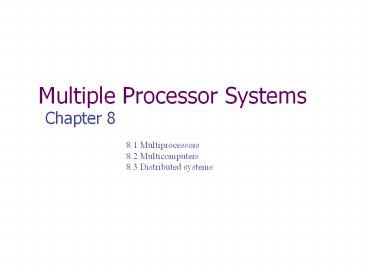Multiple Processor Systems - PowerPoint PPT Presentation
Title:
Multiple Processor Systems
Description:
Multiple Processor Systems Chapter 8 8.1 Multiprocessors 8.2 Multicomputers 8.3 Distributed systems – PowerPoint PPT presentation
Number of Views:136
Avg rating:3.0/5.0
Title: Multiple Processor Systems
1
Multiple Processor Systems
- Chapter 8
8.1 Multiprocessors 8.2 Multicomputers 8.3
Distributed systems
2
Multiprocessor Systems
- Continuous need for faster computers
- shared memory model
- message passing multiprocessor
- wide area distributed system
3
Multiprocessor Hardware (2)
- UMA Multiprocessor using a crossbar switch
4
Multiprocessor Hardware (3)
- Multiprocessors using multistage switching
networks can be built from 2x2 switches - (a) 2x2 switch (b) Message format
5
Multiprocessor Hardware (4)
- Omega Switching Network
6
Multiprocessor OS Types (1)
Bus
- Each CPU has its own operating system
7
Multiprocessor OS Types (2)
Bus
- Master-Slave multiprocessors
8
Multiprocessor OS Types (3)
Bus
- Symmetric Multiprocessors
- SMP multiprocessor model
9
Multicomputers
- DefinitionTightly-coupled CPUs that do not
share memory - Also known as
- cluster computers
- clusters of workstations (COWs)
10
Multicomputer Hardware (1)
- Interconnection topologies
- (a) single switch
- (b) ring
- (c) grid
- (d) double torus
- (e) cube
- (f) hypercube
11
Remote Procedure Call (1)
- Steps in making a remote procedure call
- the stubs are shaded gray
12
Distributed Systems (1)
- Achieving uniformity with middleware
13
Document-Based Middleware
- How the browser gets a page
- Asks DNS for IP address
- DNS replies with IP address
- Browser makes connection
- Sends request for specified page
- Server sends file
- TCP connection released
- Browser displays text
- Browser fetches, displays images
14
File System-Based Middleware (1)
(b)
(a)
- Transfer Models
- (a) upload/download model
- (b) remote access model
15
File System-Based Middleware (2)
- Naming Transparency
- (b) Clients have same view of file system
- (c) Alternatively, clients with different view
16
Network File System
- The Network File System (NFS) was developed to
allow machines to mount a disk partition on a
remote machine as if it were on a local hard
drive. This allows for fast, seamless sharing of
files across a network. - Three aspects of NFS are of interest the
architecture, the protocol, and the
implementation.
17
NFS architecture
18
NFS Architecture (contd.)
- Allows an arbitrary collection of clients and
servers to share a common file system. - In many cases all servers and clients are on the
same LAN but this is not required. - NFS allows every machine to be a client and
server at the same time. - Each NFS server exports one or more directories
for access by remote clients.
19
NFS Protocol
- One of the goals o NFS is to support a
heterogeneous system, with clients and servers
running different operating systems on different
hardware. It is essential the interface between
clients and server be well defined. - NFS accomplishes this goal by defining two
client-server protocol one for handling mounting
and another for directory and file access. - Protocol defines requests by clients and
responses by servers.
20
Mounting
- Client requests a directory structure to be
mounted, if the path is legal the server returns
file handle to the client. - Or the mounting can be automatic by placing the
directories to mounted in the /etc/rc
automounting.
21
File Access
- NFS supports most unix operations except open and
close. This is to satisfy the statelessness on
the server end. Server need not keep a list of
open connections. See the operations listed in
earlier slides. - (On the other hand consider your database
connection you create an object, connection is
opened etc.)
22
Implementation
- After the usual system call layer, NFS specific
layer Virtual File System (VFS) maintains an
entry per file called vnode (virtual I-node) for
every open file. - Vnode indicate whether a file is local or remote.
- For remote files extra info is provided.
- For local file, file system and I-node are
specified. - Lets see how to use v-nodes using a mount, open,
read system calls from a client application.
23
Vnode use
- To mount a remote file system, the sys admin (or
/etc/rc) calls the mount program specifying the
remote directory, local directory in which to be
mounted, and other info. - If the remote directory exist and is available
for mounting, mount system call is made. - Kernel constructs vnode for the remote directory
and asks the NFS-client code to create a r-node
(remote I-node) in its internal tables. V-node in
the client VFS will point to local I-node or this
r-node.
24
Remote File Access
- When a remote file is opened by the client, it
locates the r-node. - It then asks NFS Client to open the file. NFS
file looks up the path in the remote file system
and return the file handle to VFS tables. - The caller (application) is given a file
descriptor for the remote file. No table entries
are made on the server side. - Subsequent reads will invoke the remote file, and
for efficiency sake the transfers are usually in
large chunks (8K).































